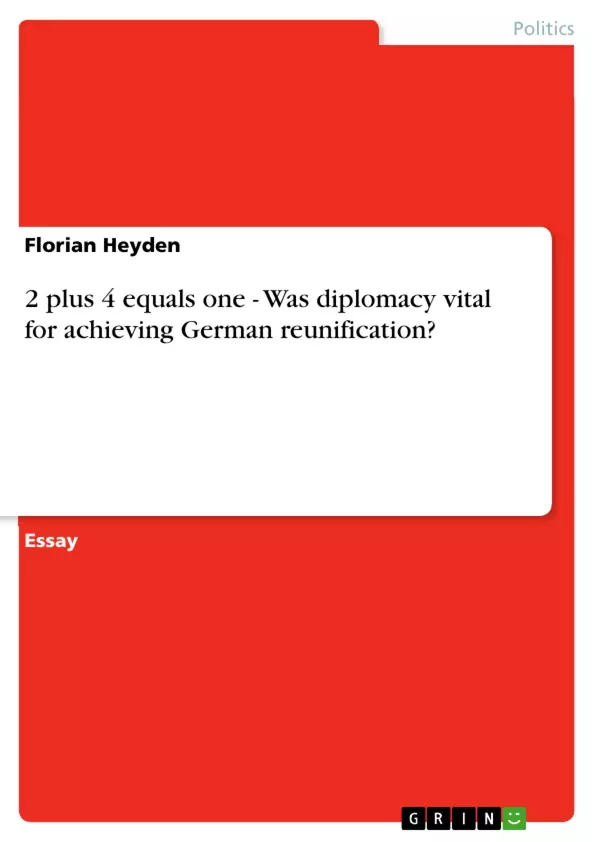Until not long before the events of 1989, political union between the two German states appeared far off. In fact, in early 1989, articles appeared in the International Herald Tribune proposing the German politicians give up the idea of German reunification1. Yet within little more than a year, Germany had acceded to full political union and sovereignty, without allies or neighbours objecting. We will ask ourselves how this seeming contradiction came to happen and what role diplomacy played in making it possible.
To do this, we will separate the course of events in two sections, the first one -less formalised- focusing more on the question if reunification would happen, followed by the second -more formalised- focusing on the terms of reunification. In the third part we will face the question what role the shape of consultations, notably the 2+4 (two German states plus four allied powers), played in the successful outcome of German moves towards reunification.
Inhaltsverzeichnis (Table of Contents)
- Introduction
- I. May 1989-March 1990
- II. March-September 1990
- III. The diplomatic process 1989-1990
- Conclusion
Zielsetzung und Themenschwerpunkte (Objectives and Key Themes)
This text explores the diplomatic processes that led to the reunification of Germany in 1990. The author examines how seemingly improbable events unfolded to achieve a unified Germany within a short period, focusing on the pivotal role of diplomacy in overcoming initial resistance and facilitating the process.
- The changing political landscape of Europe in the late 1980s, particularly the fall of the Berlin Wall and the rise of German reunification as a possibility.
- The evolving positions of key players, including the United States, the Soviet Union, France, Britain, and the two German states, on the issue of German reunification.
- The different diplomatic strategies employed by various actors to influence the course of events, such as public pronouncements, behind-the-scenes negotiations, and economic incentives.
- The impact of the 2+4 (two German states plus four allied powers) format on the diplomatic process and its contribution to the successful outcome of German reunification.
- The economic and political challenges faced by the newly unified Germany and the role of diplomacy in addressing these issues.
Zusammenfassung der Kapitel (Chapter Summaries)
- Introduction: The introduction sets the stage by highlighting the unexpected and rapid nature of German reunification, questioning how a seemingly distant possibility became a reality within a year. It outlines the text's structure, dividing the events into two phases: the early phase focusing on the feasibility of reunification and the later phase focusing on its terms. The chapter also introduces the central question of the text: what role did diplomacy play in achieving German reunification?
- I. May 1989-March 1990: This chapter examines the initial period of the German reunification process, characterized by growing civil unrest in East Germany and the emergence of calls for change. It explores the positions of various international actors, including the United States, the Soviet Union, France, and Britain, highlighting their initial reluctance towards German unification. The chapter also discusses the efforts of Chancellor Kohl to promote reunification and his use of public diplomacy and behind-the-scenes negotiations.
- II. March-September 1990: This chapter focuses on the second phase of the reunification process, marked by increasing momentum towards unification and the emergence of more formal diplomatic efforts. It analyzes the changing positions of the key actors, particularly the Soviet Union's shift towards accepting a unified Germany, and the strategies employed by France and Britain to influence the process. The chapter highlights the role of the 2+4 format in shaping the terms of reunification.
- III. The diplomatic process 1989-1990: This chapter delves into the diplomatic process of German reunification, focusing on the various actors involved, their motivations, and the strategies they employed. It examines the role of the 2+4 format in shaping the outcome and the challenges faced by the newly unified Germany. This chapter offers insights into the intricate negotiations, compromises, and agreements that were critical to achieving German reunification.
Schlüsselwörter (Keywords)
The central keywords and concepts explored in this text include: German reunification, diplomacy, international relations, Cold War, European integration, 2+4 format, Chancellor Kohl, Soviet Union, United States, France, Britain, East Germany, West Germany, political union, economic integration, and the 'German Question'.
- Quote paper
- M.A. Florian Heyden (Author), 2006, 2 plus 4 equals one - Was diplomacy vital for achieving German reunification?, Munich, GRIN Verlag, https://www.grin.com/document/54306



